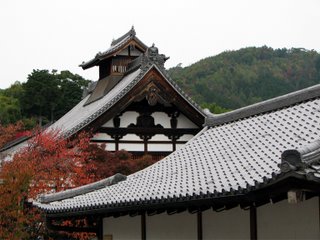Fishing For Cormorants
 Arashiyama lies on the outskirts of Kyoto and is a popular destination for tourists, particularly in late November, when the Japanese maple explodes into a riot of orange, gold and crimson (known as 'koyo'). There are plenty of things to see there, including the Togetsukyo Bridge and the Tenryuji (Heavenly Dragon) Zen Temple.
Arashiyama lies on the outskirts of Kyoto and is a popular destination for tourists, particularly in late November, when the Japanese maple explodes into a riot of orange, gold and crimson (known as 'koyo'). There are plenty of things to see there, including the Togetsukyo Bridge and the Tenryuji (Heavenly Dragon) Zen Temple.
The temple was built in 1339 and has burnt down a total of eight times since then, which seems more than just a little careless. Maybe it was all that meditation - forgetting that the oven was on etc - or just smoking in bed (cigarettes are outrageously cheap in Japan). It even withstood a crunching encounter with Jack's choppers as he came a bit of a cropper crawling across the wooden flooring. The current building is 'only' around 150 years old, but is impressive nevertheless. Even more outstanding is the landscaped garden, one of the oldest in Japan, which also dates back to the fourteenth century. The garden is a fine example of the Japanese gardening art of 'shakkei', or 'borrowed scenery' - using natural landmarks outside the garden's boundaries to create a grandiose visual composite.
The lease has a dual purpose - providing both the means to control the birds and at the same time restricting their windpipe just enough to make sure that fish are not swallowed and can be subsequently squirted back out for supper. Truly mind-boggling stuff - and to think we give the Japanese grief for whale fishing!
Postscript: While I'm not taking any sides in this particular debate, the Japanese are quite defensive about the whole whale fishing thing. First off, the minke whale is not even close to being an endangered species, and there is a suspicion that bleeding-heart western liberals might actually think it's spelt 'minky', and therefore might, just might, be a little bit cute. And even though us Brits can blame foie gras on the French, it's a recorded fact that we have fed cows... to cows! ...so we're hardly squeaky-clean on animal rights.
PS: Just in case you're wondering, I didn't take the picture above - you can find out more about the wonders of ukai here:
http://www.phototravels.net/japan/ukai-cormorant-fishing.html




0 Comments:
Post a Comment
<< Home